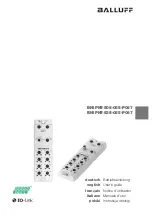
141/317
6 - STMicroelectronics Programming Tools
wish to build a table of jump addresses, you must use this order to make the jumps occur as
expected.
On the other hand, a
CALL
instruction pushes the return address Most Significant Byte first,
which means that in memory the Most Significant Byte is stored at a higher address than the
Least Significant Byte that is stored next. If you wish to write a subroutine that compares the
return address, as found in the stack, with a constant address stored in memory (for example
to identify the caller of the subroutine), you must store the constant address Least Significant
Byte first.
To allow for both cases, two sets of pseudo-ops are available:
The pseudo-ops
DC.B
,
DC.W
and
DC.L
put the Most Significant Byte first.
The pseudo-ops
BYTE
,
WORD
and
LONG
put the Least Significant Byte first.
Actually,
DC.B
and
BYTE
are equivalent, since only one byte comes into play.
The
STRING
pseudo-op is primarily used to define character strings, but actually any sequence
of bytes can be defined with it:
Message: STRING "Hello"; this message is the same as the following:
Message2: STRING 48h, 45h, 4Ch, 4Ch, 4Fh
6.1.4.2 Symbol definition
Symbols are like constant data, in that they are defined in the source text, and they cannot be
changed by program execution. The difference is, that constant data uses up bytes in memory
for storage while symbols have values at assembly time but these values do not remain in
memory at execution time. S ymbols are especially useful, however, for generating constant
data.
Syntax: a symbolic value is defined using the pseudo-op EQU. Example:
A_DOZEN EQU 12
From this time on, the word
A_Dozen
can be used anywhere the number 12 would be appro-
priate. This is useful if a value is used in several different parts of a program, but may change
if the program is revised to take account of a hardware change. For example, a program that
displays characters on a liquid-crystal display must know at various points, the number of
characters that the display is able to show:
DISPLAY_WIDTH EQU 16
















































